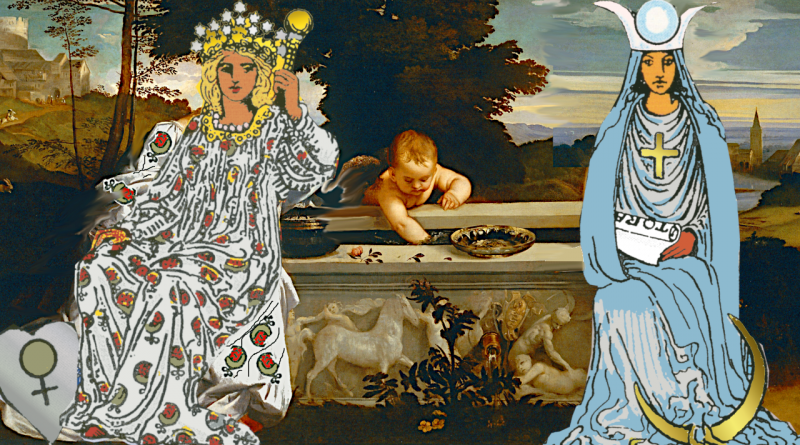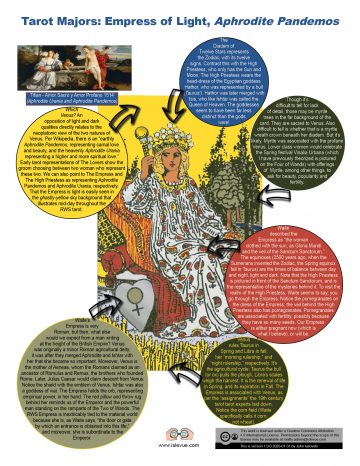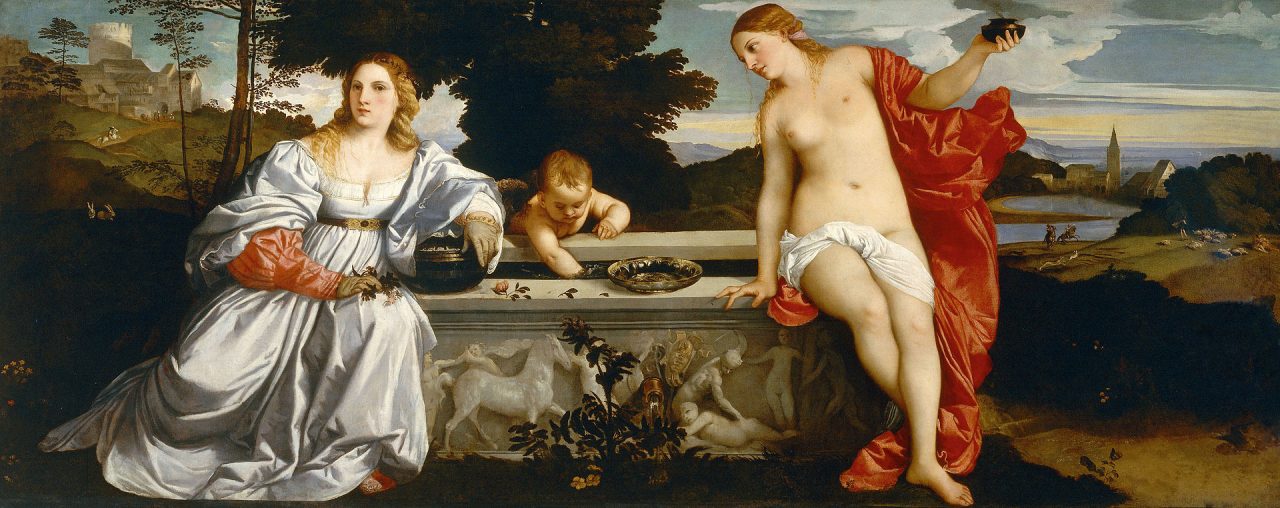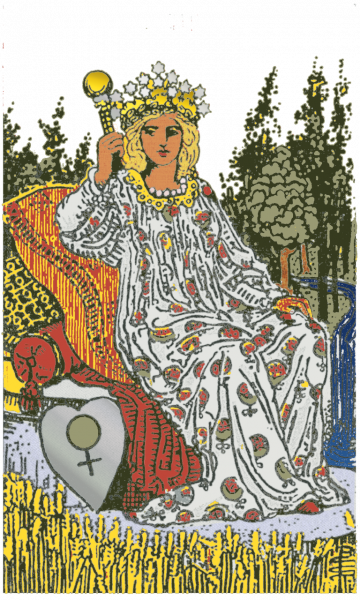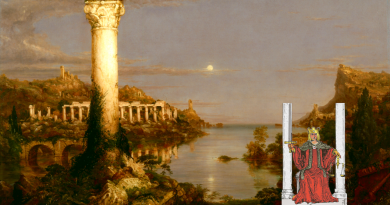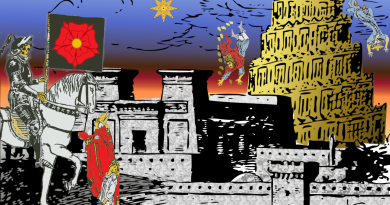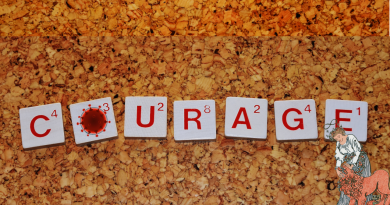The Empress of Light, Aphrodite Pandemos
Of the first seven major arcana, all having to do with the figures we might encounter in this temporal world, two of the seven represent the dual aspect of Venus. One other represents the eternal question of what to do about her? This post considers one of the goddess’ aspects: Aphrodite Pandemos, profane love, as represented by the Empress.
The post continues a format—one page, one basic thought—depicting a single aspect of a single major arcanum. So much has already been written about each of the major arcana, I see no need for me to repeat the general literature.
Where I think I have been most successful in the posts at this site is linking Tarot’s “building blocks” together and portraying them graphically (as in the Tarot Wheel and the One Page Guides) so as to better explain the whole. Therefore the format centers around a graphic, sometimes just the card itself, that sheds light on a single factor that helps make that arcanum what it is, along with (hopefully) a brief amount of text. Note the higher quality PDF download will be easier to read. Note also that most of the text in the main section below repeats the text in the PDF (so that the web indexers can scan it here, as opposed to the bitmap above), but there’s a section at the bottom with additional analysis addressing how this topic affected Waite’s divinatory meanings for the Empress.
How Do You Solve a Problem Like Venus?
Venus rules Taurus in Spring and Libra in fall; her “morning rulership,” and “night rulership,” respectively. It’s the agricultural cycle: Taurus the bull (or ox) pulls the plough, Libra’s scales weigh the harvest. It is the renewal of life in Spring, and its expiration in Fall. The Empress is associated with Venus, as per the “assignments” the 19th century tarot tarot experts laid down. The Empress carries the symbol of Venus on the shield by her side. Notice also the corn field (Waite specifically calls it corn, not wheat), representing the fertility of the Earth.
Waite described the Empress as “the woman clothed with the sun, as Gloria Mundi and the veil of the Sanctum Sanctorum.” The equinoxes (some millenia ago, when the Sumerians invented the Zodiac, the Spring equinox fell in Taurus) are the times of balance between day and night, light and dark. Note that the High Priestess is pictured in front of the Sanctum Sanctorum, and is the representative of the mysteries behind it. Yet, to visit the realm of the High Priestess, Waite seems to say, you go through the Empress. Notice the pomegranates on the dress of the Empress; the veil behind the High Priestess also has pomegranates. Pomegranates are associated with fertility, possibly because they have so many seeds. Our Empress is either pregnant now (which is what I believe), or soon will be.
This opposition of light and dark qualities directly relates to the neoplatonic view of the two natures of Venus. There is, according to Wikipedia, an “earthly Aphrodite Pandemos, representing carnal love and beauty, and the heavenly Aphrodite Urania representing a higher and more spiritual love.” Early tarot representations of the Lovers major arcanum show the groom choosing between two women who represent these two aspects. This is the reason that the Lovers card is associated with “choice,” though in my opinion, it’s as much about “commitment” as choice. We can point to the Empress and the High Priestess as representing Aphrodite Pandemos and Aphrodite Urania, respectively. That the Empress is light is easily seen in the ghastly-yellow sky background that illustrates mid-day throughout the RWS tarot.
Waite’s Empress is very Roman; but then, what else would we expect from a man writing at the height of the British Empire? Venus was originally a minor Roman agricultural deity; it was after they merged Aphrodite and Ishtar with her that she became so important. Moreover, Venus is the mother of Aeneas, whom the Romans claimed as an ancestor of Romulus and Remus, the brothers who founded Rome. Later, Julius Caesar would claim descent from Venus. Notice the shield with the emblem of Venus. Ishtar was also a goddess of war (the Romans also had Minerva in place of Athena, of course, but Venus far outranked her). The Empress holds the orb, representing empirical power, in her hand. The red pillow and throw rug behind her reminds us of the Emperor and the powerful man standing on the ramparts of the Two of Wands. The RWS Empress is inextricably tied to the material world because she is, as Waite says, “the door or gate by which an entrance is obtained into this life;” and moreover, she is subordinate to the Emperor.
Though it’s difficult to tell for lack of detail, those may be myrtle trees in the far background of the card. They are sacred to Venus. Also difficult to tell is whether that is a myrtle wreath crown beneath that diadem. But it’s likely. Myrtle was associated with the profane Venus. Lower class women would celebrate the Spring festival Vinalia Urbana (which I have previously theorized is pictured on the Four of Wands) with offerings of myrtle, among other things, to ask for beauty, popularity and fertility.
The Diadem of Twelve Stars represents the Zodiac, with its twelve signs. It helps make clear her connection with the temporal world: the year, the seasons, it’s the agricultural cycle again. The zodiac is an aid to help us know when to sow, to reap, etc. Contrast the diadem of the Empress with the High Priestess’ head-dress, who only has the Sun and Moon. She wears the head-dress of the Egyptian goddess Hathor, who was represented by a bull (Taurus again!). Hathor was later merged with Isis, who like Ishtar was called the Queen of Heaven. The goddesses seem to have been far less distinct than the gods were!
No doubt we will have to provide equal time to Aphrodite Urania and do a similar piece for the High Priestess; though I daresay the pairing on the Lovers, and what Waite and Colman Smith did to their version of the Lovers, should be more interesting!
Implications for Divinatory Meanings
We can leverage this understanding of the Empress’ identification as the "earthly Aphrodite Pandemos" to better understand Waite’s divinatory meanings for this card. To review, those meanings, as per The Pictorial Key to the Tarot, are/were:
- Upright: "Fruitfulness, action, initiative, length of days; the unknown, clandestine; also difficulty, doubt, ignorance."
- Reversed: "Light, truth, the unravelling of involved matters, public rejoicings; according to another reading, vacillation."
Here we see two main upright meanings, divided by a semi-colon, which is Waite’s normal manner of conveying two separate meanings that may or may not be related. The first is directly affected by the notion of Aphrodite Pandemos: fertility, growth, a start (Spring), a period of time (gestation). The second can only be understood when we take into account Waite’s notes regarding the Empress being the path to the High Priestess.
The reversed meanings can be seen through the lens of the perspective mechanism I’ve discussed elsewhere in this site. We can say that the upright meanings are the view of the Empress herself, considering her own role as well as looking "up the road" to her other self, Aphrodite Urania. Note that the "ignorance" of the upright meanings is due to the fact that the Empress doesn’t hold spiritual knowledge herself. The reversed could easily be seen as our view towards the two Aphrodites: first the light and truth, for the Empress is the light of the "day side" of the Equinox. Then comes either the discovery and joy when we understand that she is the first step on the path to a higher understanding, or conversely, our confusion and inaction should we not understand the way to the higher understanding.
Mighty Aphrodite, Empress of Light!
The Wikipedia articles’ copyrights are governed by the Creative Commons share-alike license.
Copyright Information: This article’s content by John Iacovelli, for islevue.com is licensed under a Creative Commons Attribution 4.0 International License. Permissions beyond the scope of this license may be available at mailto:admin@islevue.com.
This article’s content by John Iacovelli, for islevue.com is licensed under a Creative Commons Attribution 4.0 International License. Permissions beyond the scope of this license may be available at mailto:admin@islevue.com.
